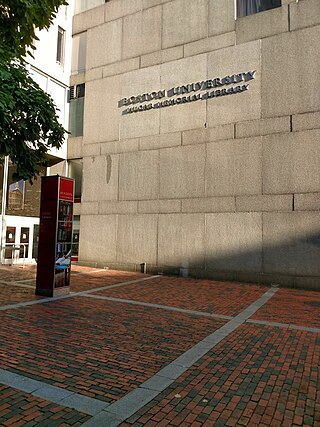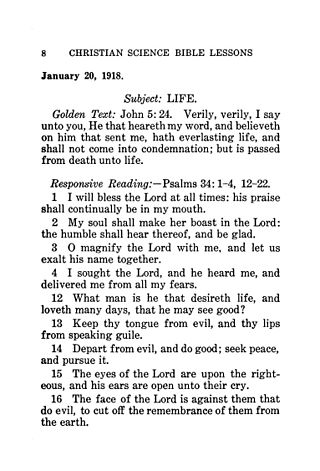
The Church of Christ, Scientist was founded in 1879 in Boston, Massachusetts, by Mary Baker Eddy, author of Science and Health with Key to the Scriptures, and founder of Christian Science. The church was founded "to commemorate the word and works of Christ Jesus" and "reinstate primitive Christianity and its lost element of healing".

Mary Baker Eddy was an American religious leader and author who founded The Church of Christ, Scientist, in New England in 1879. She also founded The Christian Science Monitor in 1908, and three religious magazines: the Christian Science Sentinel, The Christian Science Journal, and The Herald of Christian Science. She wrote numerous books and articles, the notable of which were Science and Health with Key to the Scriptures and Manual of The Mother Church. Other works were edited posthumously into the Prose Works Other than Science and Health.

Christian Science is a set of beliefs and practices which are associated with members of the Church of Christ, Scientist. Adherents are commonly known as Christian Scientists or students of Christian Science, and the church is sometimes informally known as the Christian Science church. It was founded in 1879 in New England by Mary Baker Eddy, who wrote the 1875 book Science and Health with Key to the Scriptures, which outlined the theology of Christian Science. The book became Christian Science's central text, along with the Bible, and by 2001 had sold over nine million copies.

The Destiny of The Mother Church is a book about Christian Science written by Bliss Knapp, published privately by him in 1947, and publicly in 1991 by Christian Science Publishing Society. Knapp and his parents, Ira O. and Flavia Stickney Knapp, all knew Christian Science founder Mary Baker Eddy. His parents were students of hers and his father was one of the original members of the Board of Directors of The First Church of Christ, Scientist. Until 1991, the book was repeatedly rejected for publication by the church's Board of Directors because of its depiction of Eddy as the fulfillment of biblical prophecy and equating her with Christ Jesus, a position which Eddy considered blasphemous. Destiny's publication caused divisions within the church, including several resignations of prominent church employees. Critics claimed that the failure of the church's then-recent television venture, which had cost the church several hundred million dollars, had motivated the Board's reversal on publishing Knapp's book. Knapp, his wife and her sister left wills that granted bequests totalling over $100 million promised to the church if the book were to be published. The wills set a time limit of 20 years for the book to be published, otherwise the bequests were to be divided between Stanford University and the Los Angeles County Museum of Art, and the church would receive nothing. The 1973 death of Knapp's wife set the date of the time limit to May 1993.

The Christian Science Publishing Society was established in 1898 by Mary Baker Eddy and is the publishing arm of The First Church of Christ, Scientist in Boston, Massachusetts.
The following outline is provided as an overview of and topical guide to Christian theology:
A Christian Science practitioner is an individual who prays for others according to the teachings of Christian Science. Treatment is non-medical, rather it is based on the Bible and the Christian Science textbook, Science and Health with Key to the Scriptures (1875) by Mary Baker Eddy (1821–1910), who said she discovered Christian Science in 1866 and founded the Christian Science church in 1879. According to the church, Christian Science practitioners address physical conditions, as well as relationship or financial difficulties and any other problem or crisis.
Prose Works other than Science and Health with Key to the Scriptures, sometimes called Prose Works other than Science and Health or simply Prose Works, is a single-volume compendium of the major works of Mary Baker Eddy, the founder of Christian Science, outside of her main work, Science and Health with Key to the Scriptures. Also not included are Eddy's Church Manual, Poems, and Christ and Christmas. The books included in Prose Works were never published together as a single volume during her lifetime but were assembled as a convenience around 1925. When published it became the most popular book printed by the Christian Science Publishing Society besides Science and Health and the Church Manual. The constituent books have historically been published individually in parallel also. It has been issued in both hardcover and paperback.
The Christian Science Hymnal is a collection of hymns used in Christian Science church services including Sunday services and Wednesday evening testimony meetings, as well as in occasional informal hymn sings.
In Christian communities, Bible study is the study of the Bible by people as a personal religious or spiritual practice. In many Christian traditions, Bible study, coupled with Christian prayer, is known as doing devotions or devotional acts. Many Christian churches schedule time to engage in Bible study collectively. The origin of Bible study groups has its origin in early Christianity, when Church Fathers such as Origen and Jerome taught the Bible extensively to disciple Christians. In Christianity, Bible study has the purpose of "be[ing] taught and nourished by the Word of God" and "being formed and animated by the inspirational power conveyed by Scripture".

The Mugar Memorial Library is the primary library for study, teaching, and research in the humanities and social sciences for Boston University. It was opened in 1966. Stephen P. Mugar, an Armenian immigrant who was successful in the grocery business, provided the naming gift to commemorate his parents. Mugar's entrance carries an inscription from Stephen honoring his parents.
In coming to America from Armenia my parents opened the door of Freedom to me. America's public schools & libraries opened my eyes to the unlimited opportunity in this great land, as well as the privileges and obligations of citizenship. May this library serve over the years as a similar inspiration to all who use it. In memory of my father and mother Sarkis and Vosgitel Mugar. By their grateful son
– Stephen P. Mugar –

Josephine Emma Curtis Hopkins was an American spiritual teacher and leader. She was involved in organizing the New Thought movement and was a theologian, teacher, writer, feminist, mystic, and healer; who taught and ordained hundreds of people, including notably many women. Hopkins was called the "teacher of teachers" and "mother of New Thought" because a number of her students went on to found their own churches or to become prominent in the New Thought Movement, including Charles and Myrtle Fillmore, founders of Unity Church; Ernest Holmes; and H. Emilie Cady, author of Unity's cornerstone text Lessons in Truth. According to Charles S. Braden, Hopkins influenced the development of New Thought "more than any other single teacher", and modern scholars have identified Hopkins as the founder of New Thought.

Septimus James Hanna, an American Civil War veteran and a judge in the Old West. He was a student of Mary Baker Eddy, who founded the Christian Science church. Giving up his legal career, he became a Christian Science practitioner, lecturer and teacher. Hanna occupied more leading positions within the church organization than any individual, serving as pastor, then First Reader of The Mother Church, as editor and associate editor of the periodicals, member of the Bible Lesson Committee, he served two terms as president of The Mother Church, he was teacher of the Normal (teachers) Class of 1907, later vice president and then president of the Massachusetts Metaphysical College.

The Congregational Library & Archives is an independent special collections library and archives. It is located on the second floor of the Congregational House at 14 Beacon Street in the Beacon Hill neighborhood of Boston, Massachusetts. The Library was founded in 1853 by a gathering of Congregational ministers and has since evolved into a professional library and archives that holds more than 250,000 items, predominantly focused on 18th to 21st century American Congregational history. The Library's reading room is free and open to the public for research but the Library's stacks are closed and book borrowing privileges are extended exclusively to members.

The Mary Baker Eddy Library is a research library, museum, and repository for the papers of Mary Baker Eddy, the founder of Christian Science.

The Christian Science Quarterly is a publication of the Christian Science Publishing Society that sets out the Bible lessons for all students of Christian Science. Each lesson serves as the Sunday sermon in church and is studied for the week preceding the Sunday on which it is read as the sermon.
A Reader in a Christian Science church is a member of the congregation who has been elected to serve in one of two positions responsible for church services. Each week's sermon in Christian Science churches is outlined in the Christian Science Quarterly, prepared months in advance, and is the same in all Christian Science churches, worldwide. As a lay church, the congregation elects readers from the congregation and they serve as readers for a set period of time. The sermons consist of passages from the Bible and Science and Health with Key to the Scriptures by Mary Baker Eddy, and are studied as lessons during the week and read aloud to the congregation on the Sunday following.
Conservative Mennonites include numerous Conservative Anabaptist groups that identify with the theologically conservative element among Mennonite Anabaptist Christian fellowships, but who are not Old Order groups or mainline denominations.

The Kenton Library is a branch of the Multnomah County Library (MCL), in the Kenton neighborhood of Portland in the U.S. state of Oregon. Preceded by reading rooms in North Portland and later by the Lombard Branch Library, the Kenton Library opened in 2010 in a storefront on North Denver Avenue. The branch offers the MCL catalog of two million books, periodicals and other materials.

Sibyl Marvin Huse was a French-born American author of religious books and teacher of Christian Science. Huse holds a prominent place in the Christian Science movement and has a large clientele of devoted students who testify to her spiritual understanding and clear teaching of the beliefs as promulgated by Mary Baker Eddy. Huse was the author of four books on religion. As a life-long student of the beginnings of the Anglo-Saxon race, she read history in the light of Bible prophecy and while substantiating the claims of Professor Charles H. L. Totten and other experts who traced the lost tribes of Israel to the Anglo-Saxons of England and the U.S., she added interesting revelations from the metaphysical standpoint.














